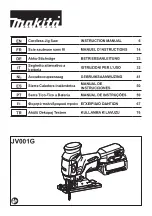
GB
- 43 -
Important.
The integral resetting springs will
automatically lift the machine head. Do not simply
let go of the handle (1) after cutting, but allow the
machine head (4) to rise slowly, applying slight
counter pressure as it does so.
6.2 Cross cut 90° and turntable 0° - 45°
(Fig. 1-3, 12)
The crosscut saw can be used to make crosscuts
of 0°- 45° to the left and 0° - 45° to the right in re-
lation to the stop rail.
•
Release the turntable (17) by slackening the
locking screw (14).
•
Turn the turntable (17) and scale pointer (15)
to the desired angular setting on the dial (16)
and lock into place with the locking screw
(14). The saw has locking positions at angles
of - 45°, -31.6°, -22.5°, -15°, 0°, 15°, 22.5°,
31.6° and 45°, at which the turntable (17) au-
dibly clicks into position.
•
Retighten the locking screw (14) to secure the
turntable (17) in place.
•
Cut as described under section 6.1.
6.3 Miter cut 0°- 45° and turntable 0°
(Fig. 1-3, 13)
The crosscut saw can be used to make miter cuts
to the left of 0°-45° and to the right of 0°-45° in
relation to the work surface.
•
If required, dismantle the clamping device
(8) or mount on the opposite side of the fixed
saw table (18).
•
Move the machine head (4) to its upper posi-
tion.
•
Fasten the turntable (17) in 0° position.
•
Adjust the miter angle on the machine head
and the stop rail as described under points
5.5 and 5.6.
•
Cut as described under section 6.1.
6.4 Miter cut 0°- 45° and turntable 0°- 45°
(Fig. 1-3, 14)
The crosscut saw can be used to make miter cuts
to the left of 0°-45° and to the right of 0°-45° in
relation to the work surface, with simultaneous
setting of the turntable from 0°-45° to the left or
0°-45° to the right in relation to the stop rail (dou-
ble miter cut).
•
If required, dismantle the clamping device
(8) or mount on the opposite side of the fixed
saw table (18).
•
Move the machine head (4) to its upper posi-
tion.
•
Release the turntable (17) by slackening the
locking screw (14).
•
Use the handle (1) to adjust the turntable (17)
to the angle required (in this connection see
also section 6.2).
•
Retighten the locking screw (14) to secure the
turntable in place.
•
Adjust the miter angle on the machine head
and the stop rail as described under points
5.5 and 5.6.
•
Cut as described under section 6.1.
6.5 Limiting the cutting depth (Fig. 15)
•
The cutting depth can be infinitely adjusted
using the screw (27). Turn the screw (27) in or
out to set the required cutting depth and then
retighten the knurled nut on the screw (27).
•
Check the setting by completing a test cut.
6.6 Sawdust bag (Fig. 2)
The saw is equipped with a debris bag (22) for
sawdust and chips.
The debris bag (22) can be emptied by means of
a zipper at the bottom (1).
6.7 Changing the saw blade (Fig. 1, 16-18)
•
Before changing the saw blade: Remove the
power plug!
•
Wear work gloves to prevent injury when
changing the saw blade.
•
Swing the machine head upwards (4).
•
Undo the screw (z) on the cover plate (f) of
the saw blade.
•
Pull back the adjustable blade guard (6) and
at the same time turn the cover plate to achie-
ve access to the flange bolt.
•
Press the saw shaft lock (5) with one hand
while positioning the Allen key (d) on the
flange bolt (31) with the other hand. The saw
shaft lock (5) engages after no more than one
rotation.
•
Now, using a little more force, slacken the
flange screw (31) in the clockwise direction.
•
Turn the flange screw (31) right out and remo-
ve the external flange (32).
•
Take the blade (7) off the inner flange and pull
out downwards.
•
Carefully clean the flange screw (31), outer
flange (32) and inner flange.
•
Fit and fasten the new saw blade (7) in rever-
se order.
•
Important. The cutting angle of the teeth, in
other words the direction of rotation of the
saw blade (7) must coincide with the direction
of the arrow on the housing.
•
Check to make sure that all safety devices
are properly mounted and in good working
Anl_TC_SM_2131_Dual_SPK8.indb 43
Anl_TC_SM_2131_Dual_SPK8.indb 43
10.07.2018 08:16:39
10.07.2018 08:16:39
















































